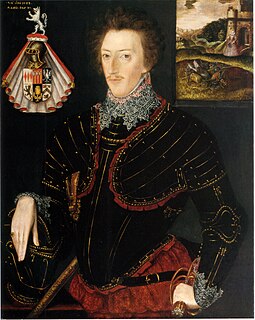
Earl of Winchilsea is a title in the Peerage of England held by the Finch-Hatton family. It has been united with the title of Earl of Nottingham under a single holder since 1729. The Finch family is believed to be descended from Henry FitzHerbert, Lord Chamberlain to Henry I. The name change to Finch came in the 1350s after marriage to an heiress by a member of the Finch family. In 1660 the 3rd Earl of Winchilsea was created Baron FitzHerbert of Eastwell, Kent, in recompense for his efficient aid in the Restoration of the Monarchy. The Herbert family of Wales, Earls of Pembroke, share common ancestry but bear differenced arms. A later member of the family, Sir William Finch, was knighted in 1513. His son Sir Thomas Finch, was also knighted for his share in suppressing Sir Thomas Wyatt's insurrection against Queen Mary I, and was the son-in-law of Sir Thomas Moyle, some of whose lands Finch's wife inherited. Thomas's eldest son Moyle Finch represented Weymouth, Kent and Winchelsea in the House of Commons. In 1611 he was created a baronet, of Eastwell in the County of Kent.
There has been a Lord Lieutenant of Buckinghamshire almost continuously since the position was created by King Henry VIII in 1535. The only exception to this was the English Civil War and English Interregnum between 1643 and 1660 when there was no king to support the Lieutenancy. The following list consists of all known holders of the position: earlier records have been lost and so a complete list is not possible. Since 1702, all Lord Lieutenants have also been Custos Rotulorum of Buckinghamshire.
This is an incomplete list of people who have served as Lord Lieutenant of Somerset. Since 1714, all Lord Lieutenants have also been Custos Rotulorum of Somerset.
This is a list of people who have served as Lord-Lieutenant of Kent. Since 1746, all Lords Lieutenant have also been Custos Rotulorum of Kent.
This is a list of people who have served as Lord-Lieutenant of Westmorland. The office was abolished on 31 March 1974 and replaced by the Lord Lieutenant of Cumbria. From 1751 to 1974, all Lord Lieutenants were also Custos Rotulorum of Westmorland.
This is a list of people who have served as Custos Rotulorum of Kent.
The holder of the post Vice-Admiral of Cumberland was responsible for the defence of the county of Cumberland, England.
The holder of the post Vice-Admiral of Devon was responsible for the defence of the county of Devon, England.
The Vice-Admiral of the coast of Durham was responsible for the defence County Durham, England.
The Vice-Admiral of Dorset was responsible for the defence County of Dorset, England.
Charles Finch, 4th Earl of Winchilsea PC was a British peer and Member of Parliament, styled Viscount Maidstone until 1689. He was the son of William Finch, Lord Maidstone and Elizabeth Wyndham.

The Admiral of the West, also known as Admiral of the Western Seas or Admiral of the Western Fleet, was formerly an English Navy appointment. The postholder was chiefly responsible for the command of the English navy's fleet based at Portsmouth, which operated in the English Channel, Irish Sea and Atlantic Ocean, from 1294 to 1412.









